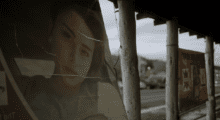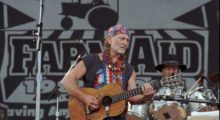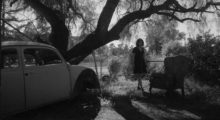17728 Results for “”
-
“It Was up to the Subject To Choose Their Own Eyeline”: DP Bobby Bukowski on Willie Nelson & Family

Filmmakers Thom Zimny and Oren Moverman capture the seven decade-spanning legacy of one of America’s greatest living musicians in Willie Nelson & Family, a seven-part docuseries that weaves together archival and present-day footage to create a non-linear portrait of an iconic artist. DP Bobby Bukowski talks about lensing the series, touching upon his longtime collaboration with Moverman and how “no artificial enhancement was employed” on the shoot. See all responses to our annual Sundance cinematographer interviews here. Filmmaker: How and why did you wind up being the cinematographer of your film? What were the factors and attributes that led to […]
by Filmmaker Staff on Feb 4, 2023 -
“Figuring Out How and When to Peel Back the Layers of the Story Was Crucial”: Editor David Mehlman on Murder in Big Horn



The epidemic of Missing and Murdered Indigenous Women (MMIW) in Montana’s Big Horn County and its surrounding areas is the focus of the doc Murder in Big Horn from directors Razelle Benally and Matthew Galkin. With dozens of young women and girls from Crow and Northern Cheyenne Nations having gone missing over the past decade, the filmmakers utilize interviews with grieving loved ones, Native journalists and local law enforcement to try and understand the circumstances surrounding these tragic cold cases. Editor David Mehlman talks about cutting the three-part docuseries, including his longstanding collaboration with much of the team involved. See […]
by Filmmaker Staff on Feb 4, 2023 -
“It All Mirrored Willie’s World” | Thom Zimny and Oren Moverman, Willie Nelson & Family



Every production faces unexpected obstructions that require creative solutions and conceptual rethinking. What was an unforeseen obstacle, crisis, or simply unpredictable event you had to respond to, and how did this event impact or cause you to rethink your film? The obvious unforeseen obstacle, crisis, and unpredictable event we had to respond to in making Willie Nelson & Family was the pandemic. But the impact on the process was surprising. As most people know (if they don’t, they will after seeing the five-part documentary film), Willie Nelson lives on the road. He always has to be on the bus, on […]
by Filmmaker Staff on Feb 4, 2023 -
“You Hope the Work Can Play a Small Part in Moving the Needle Forward”: DP Jeff Hutchens on Murder in Big Horn



Dozens of Indigenous women and girls from the Crow and Northern Cheyenne Nations have gone missing over the past decade in Montana’s Big Horn County and its surrounding areas. These cases often go cold, leaving grieving families without any closure—especially when met with the ambivalence of local police. Murder in Big Horn, a documentary from directors Razelle Benally and Matthew Galkin, confronts the epidemic of Missing and Murdered Indigenous Women (MMIW) by interviewing loved ones in mourning, Native journalists and law enforcement. DP Jeff Hutchens talks about shooting this project with the utmost sensitivity while also capturing the “palette of […]
by Filmmaker Staff on Feb 4, 2023 -
“My Techniques Are Intuitive”: Editors Marc Boucrot and Jacqueline Castel on My Animal




Lycanthropy serves as a metaphor for burgeoning queer desire in My Animal from director Jacqueline Castel. Heather (Bobbi Salvör Menuez) is a benchwarmer on her local hockey team and deals with an alcoholic mother at home. Adding to her misery is the fact that she’s confined to her quarters during each full moon due to a dangerous transformation occurring within her. She finally finds a salve in Jonny (Amandla Stenberg), a figure skater who recently moved to town. Desperate to flee from her myriad problems, Heather hopes that Jonny will join her on the journey to society’s outskirts. Edited by […]
by Filmmaker Staff on Feb 4, 2023 -
“It Was -30 to -40 Degrees Celsius for Most of the Shoot”: DP Bryn McCashin on My Animal




Heather (Bobbi Salvör Menuez), a hockey player with a troubled home life, becomes instantly drawn to figure skater Jonny (Amandla Stenberg) who’s just rolled into town. Despite being held captive in her own house during each full moon, Heather yearns to escape and have Jonny by her side. Teeming with queer sensuality and lust-fueled lycanthropy, director Jacqueline Castel’s My Animal injects originality into a classic monster mythology. DP Bryn McCashin tells Filmmaker about lensing the film, which entailed frigid night shoots in Northern Ontario, Canada. See all responses to our annual Sundance cinematographer interviews here. Filmmaker: How and why did […]
by Filmmaker Staff on Feb 4, 2023 -
“It Cost Us Nearly a Quarter of Our Budget To Be Shut Down for Two Weeks” | Jacqueline Castel, My Animal




Every production faces unexpected obstructions that require creative solutions and conceptual rethinking. What was an unforeseen obstacle, crisis, or simply unpredictable event you had to respond to, and how did this event impact or cause you to rethink your film? My Animal was not an easy shoot—we shot nights in the dead of winter in an isolated community in Northern Ontario. While there were a lot of challenges, the biggest and most obvious crisis we faced as a team was a COVID shutdown that resulted in a two week suspension of the shoot. This was what I had feared the […]
by Filmmaker Staff on Feb 4, 2023 -
“Marjaneh Moghimi, the Lead Producer of the Film, Unfortunately Passed Away” | Babak Jalali, Fremont


Every production faces unexpected obstructions that require creative solutions and conceptual rethinking. What was an unforeseen obstacle, crisis, or simply unpredictable event you had to respond to, and how did this event impact or cause you to rethink your film? The way Fremont went into production was influenced by a very sad event. Marjaneh Moghimi, the lead producer of the film, unfortunately passed away a couple of weeks into pre-production, which was also about two weeks before we started shooting. This was a film we had worked on together for a few years. Once we knew about her condition, the […]
by Filmmaker Staff on Feb 4, 2023 -
“A Rare Series of Earthquakes Shook the Island” | Glorimar Marrero Sánchez, La Pecera



Every production faces unexpected obstructions that require creative solutions and conceptual rethinking. What was an unforeseen obstacle, crisis, or simply unpredictable event you had to respond to, and how did this event impact or cause you to rethink your film? Unpredictable events and obstacles were constant factors during the development of La Pecera (The Fishbowl). In 2017, Puerto Rico was embattled by a category 4 hurricane that caused catastrophic damage across the island and impacted the priorities of many people involved in our production. Then in 2020, a rare series of earthquakes shook the island. These two events led to […]
by Filmmaker Staff on Feb 4, 2023 -
“We Had To Capture Bioluminescence on Camera in the Most Organic Way”: DP PJ López on La Pecera



In La Pecera, the feature debut from writer-director Glorimar Marrero Sánchez, Noelia (Isel Rodríguez) decides to relocate to the Puerto Rican island of Vieques where she grew up after her cancer returns. Reunited with her mother and the island’s natural beauty (and traumatic past of being a U.S. Army testing ground), Noelia refuses treatment and reflects on the root of her long-term illness. DP PJ López discusses lensing the film, which included a difficult night shoot that captured bioluminescence on camera. See all responses to our annual Sundance cinematographer interviews here. Filmmaker: How and why did you wind up being […]
by Filmmaker Staff on Feb 4, 2023
